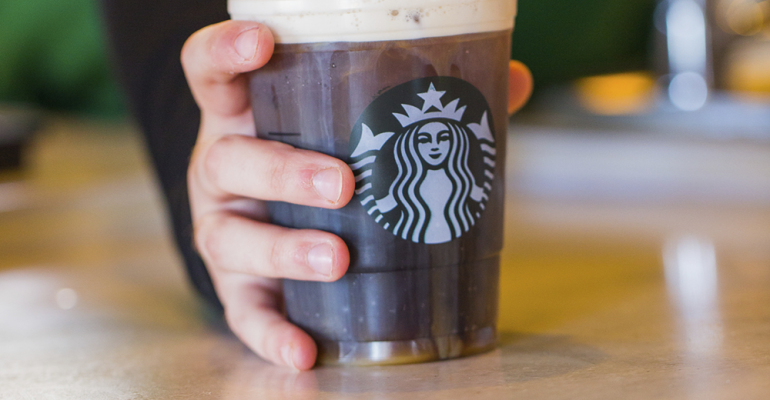Most companies reporting this quarter are experiencing sales and traffic growth as we lap last year’s COVID-19 Omicron challenges. Starbucks is no exception, reporting 11% global same-store sales growth for the second quarter ended April 2, driven by a mix of average ticket growth and traffic, though the company has been experiencing a surge of momentum for several quarters now.
Much of Starbucks’ momentum this quarter is driven by digital engagement and menu innovation. Omnichannel accessibility was crucial to the company’s growth as Mobile order and pay, drive thru, and delivery together accounted for 74% of U.S. revenue in Q2, and the loyalty program experienced 15% growth with now more than half of transactions coming from loyalty members.
Last quarter, Starbucks began rolling out its line of olive oil-infused Oleato beverages, conceptualized by founder Howard Schultz. Although reviews of the olive oil-coffee blends were mixed, new CEO Laxman Narasimhan said that the Oleato has already reached five billion sales, making it one of the most successful product launches in the company’s history. The second quarter also saw record sales of sous vide egg bites, giving the food category a boost alongside the much-lauded beverage categories. Starbucks is even experiencing success in retail, as the company’s ready to drink beverages — including the new packaged Pink Drink — has become the number one in its category in the U.S.
“Scaled profitable innovation is one of the things that fuels our performance,” Laxman Narasimhan said during his first earnings call as CEO on Tuesday. “[…] “You can expect us to lean strongly on purposeful innovation to further capture that tremendous opportunity, both in what we do and in how we do it.”
But this successful quarter comes at a tumultuous time for Starbucks, and Narasimhan’s restrained remarks and company outlook reflected that. As Starbucks continues to face clashes with union leaders both inside and outside the courtroom (the latest is the NLRB accusing Starbucks of refusing to negotiate with 144 unionized stores), much of Narasimhan’s prepared remarks addressed issues with employees. Though the new CEO never addressed the union by name, he did admit that there were still problems with staff mental health, scheduling, and turnover rates.
“Our performance is strong, but our health can be stronger,” Narasimhan said. “[…] We need to think of our businesses as a theater in the front and a factory in the back—to simplify the store partner experience and drive greater productivity within and beyond the store level […] For example, today, our store deliveries involve a high-touch one-size-fits-all model. We’re out of stock of more items than we’d like. We need to be able to lower costs while creating a better experience for our partners and ultimately our customers.”
Before stepping down officially from his role as CEO, Howard Schultz referred to the changes coming to employee and customer experience as a “reinvention” and now Narasimhan is calling it a “refounding” of the company. Improvements already made to the Starbucks partner experience include the rollout of a universal tipping system at the end of 2022 and testing of the new “Siren System” which automates and simplifies much of the beverage creation process—supposedly cutting down on the time spent trying to catch up on customer orders. Sara Trilling, president of Starbucks North America, said that speed of service and productivity numbers are up, which show that the Siren System rollout is working.
Moving forward, Starbucks wants to tackle scheduling issues, which have been one of the top complaints of baristas that vote to unionize. Narasimhan said that they’ve been able to deliver 4% more hours to employees last quarter, and staff turnover rates were down by 9% year over year, though he admits they have a long road to go.
“We fully acknowledge the need to evolve and modernize our brand, our business, our capabilities, and our culture to meet the needs of an ever-changing world,” Narasimhan said. “[…] Starbucks continues to be a brand with a very strong employee value proposition. And we are able to attract a lot of applicants for the jobs that we have open. We’re seeing growing stabilization in what we see on our front line. As I mentioned, we are seeing lower levels of attrition and greater stabilization in in our retail talent. Additionally, as you look at the improvements that we are making in our scheduling processes, […] that has an impact on the compensation partners can have.”
Starbucks’ net revenues were up 14% in Q2 to $8.7 billion. The company’s net income for Q2 increased 34.7% from $674.5 million or $0.58 per share to $908 million or $0.79 per share. The company opened 464 net new stores in Q2, ending the quarter with 36,634 stores globally.
Contact Joanna at [email protected]

